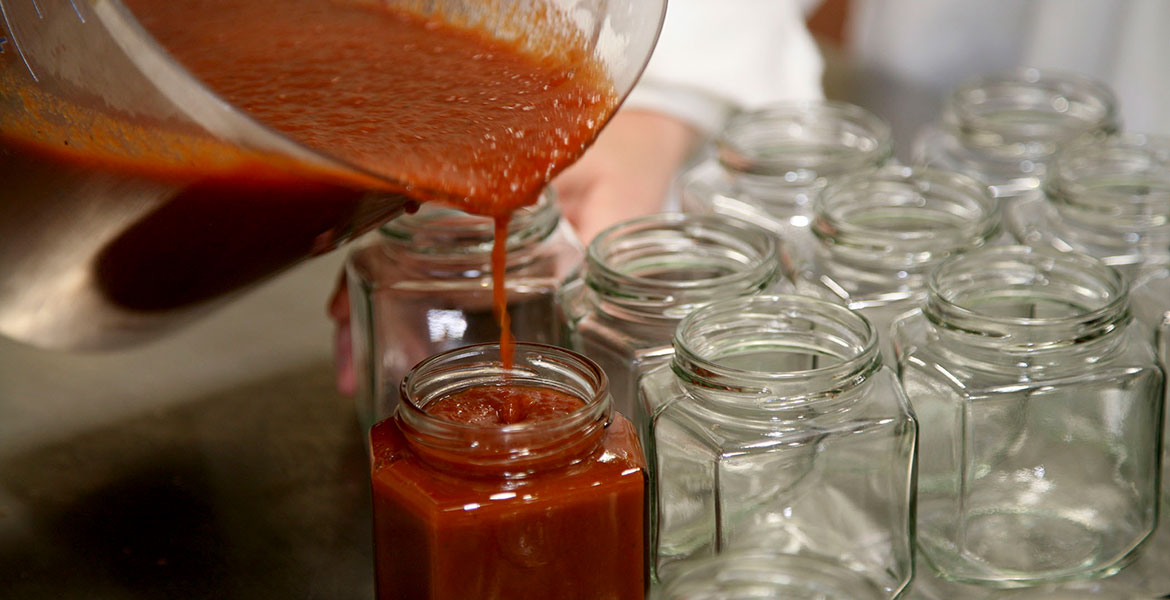
From scratch to market: Commercializing a food product
Tuesday, April 16, 2019
Your friends tell you your salsa is the best they ever tasted. Your mother has been serving her “world’s best” homemade jelly for years. Your grandmother’s pasta sauce is the hit of every family gathering. You think about selling your food product, but you don’t know where to begin.
Oklahoma State University’s Robert M. Kerr Food & Agricultural Products Center, a part of the Division of Agricultural Sciences and Natural Resources, has experts who specialize in helping entrepreneurs commercialize homemade recipes.
Erin Johnson, FAPC business and marketing client coordinator, said many entrepreneurs with dreams of commercializing a food product contact the center asking help with a recipe they created in their home kitchen.
“The clients’ goals are to produce their products on a mass scale, but they don’t know the steps needed to produce a market-ready product,” she said.
To gain an understanding of these steps, entrepreneurs are encouraged to attend FAPC’s Basic Training Workshop, which provides participants the fundamental tools necessary to market a successful product.
The workshop, which costs $200 per person and is held on the third Thursday of the even months, helps participants understand common topics every potential food processor should consider, such as business planning, market identification, trademarks, health regulations, contract packaging and more.
Participants also learn about the technical assistance FAPC can provide to individual companies, including product testing and evaluation, process scale up, pilot processing, engineering and analytical services, Johnson said.
“Depending on the product, the scale-up can be completed in about six hours within one visit at the center,” Johnson said. “FAPC completes about 10 recipe scale-ups per year for a variety of different food products; the most popular being jams, jellies, sauces, salsas and condiments.”
Darren Scott, FAPC food scientist and sensory specialist, said there are three steps in scaling-up a product recipe for mass production, packaging and distribution, starting with a satisfactory product.
The first step is converting units of measurement that are used at home to units typically used in the industry.
FAPC takes the dashes, pinches, cups and other standardized units used by the client and converts them to pounds, grams or gallons. The ingredients also are converted to percentages for the distribution process.
“The reason for using percentages is because an up-scaled recipe may call for 98 tablespoons to make a larger batch,” Johnson said. “However, this measurement is unrealistic once in a large production setting.”
The client then typically takes the percentages to a contract packager, or co-packer, to scale-up their recipe for distribution. FAPC recommends clients conduct research before picking a co-packer.
“Co-packers can be selected by reviewing their cost of services, production records and experiences with similar products,” Scott said. “FAPC provides clients a list of questions that can be used during an interview with a potential co-packer.”
Scaling-up a recipe not only is about the ingredient percentages, but also the business side of production, Johnson said.
“Many producers come to FAPC for assistance and don’t realize their production costs,” she said. “Initially, they will often purchase home-style ingredients for their product at retail cost, but once they transition to a commercial scale, they need to switch their ingredients to a cheaper alternative that will lower their production costs.”
The next step in the scale-up process is observing the batch and noting any changes that may have occurred, compared to the original recipe.
“Obviously, this is done because the original recipe is the target,” Scott said. “Sometimes it is possible to predict what changes may occur in a scaled-up recipe, but that is not often the case.”
When scaling-up a recipe, the ingredients sometimes react differently when produced on a larger scale.
“Scaled-up batches of a product may be very different from the original formula because of differences in taste, texture, aroma or appearance,” Scott said. “Foods are a complex system of interacting physical and chemical properties. When the product is scaled-up, the function of these properties changes.”
The scaled-up products often receive a higher degree of scrutiny compared to home-style products, Scott said. The scaled-up batch makes observing flaws easier, which may have already existed in the smaller batch.
“It should be noted that many times the scaled-up batches are often not better or worse than the original,” Scott said. “They’re just different.”
However, some ingredients are more difficult to scale up than others. For example, when mixing spices with lighter-colored ingredients in larger quantities, it is likely for the colors to run or bleed together.
Fruits and vegetables can be difficult, as well. Scott said it is important to consider whether the fruit and vegetable commodities need to be peeled, cored or seeded when scaling-up the recipe.
“The client will sometimes change the ingredients, so the product will work better on a larger scale,” Johnson said. “It’s a trial and error experience. In some cases, it might not be possible to make the scaled-up batch identical to the original small batch.”
The final step in scaling-up a recipe is making adjustments to the scaled-up recipe.
“The ultimate goal is making the subsequent batches of the recipe closely matched to the original recipe,” Scott said. “This may involve changes in the ingredients, changes in the equipment used to make the recipe, or both.”
FAPC is dedicated to helping entrepreneurs succeed in producing their product, Johnson said.
In addition to product scale-up, FAPC offers a variety of resources, workshops and trainings to assist food entrepreneurs in creating a product.
“The food product scale-up is an exciting and challenging process that requires an organized, flexible and consistent approach for success,” Scott said. “Success often is achieved when a recipe and process for commercial production is accomplished and is ultimately measured in terms of the food product’s profitability and customer satisfaction.”
To learn more about FAPC, visit www.fapc.biz or download the free FAPC Connect app by texting FAPC to 80802 or visiting www.fapcconnect.com.
